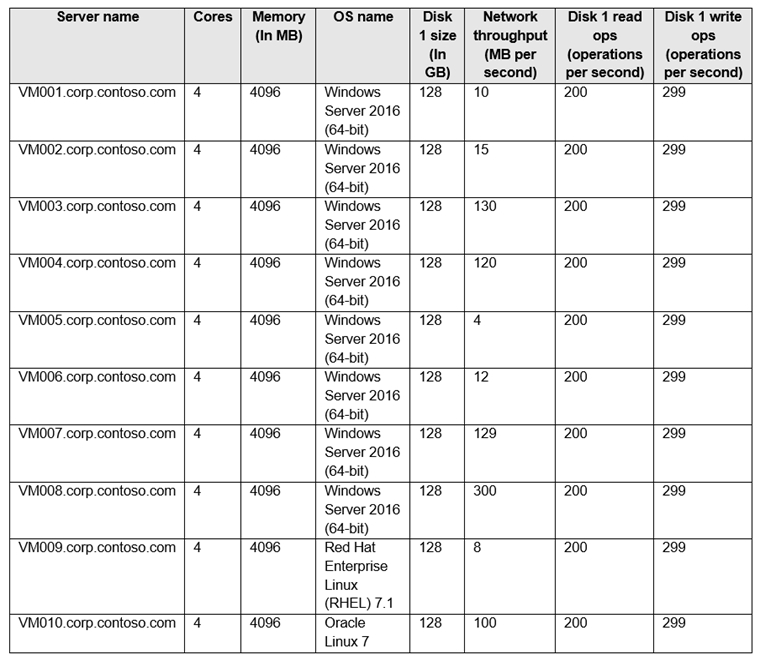Microsoft Configuring and Operating a Hybrid Cloud with Microsoft Azure Stack Hub AZ-600 Exam Practice Test
You plan to deploy an Azure Stack Hub integrated system that will connect to the Internet.
You need to define the public VIP pool.
What is the smallest subnet mask that you can use for the public VIP pool?
Answer : C
https://docs.microsoft.com/en-us/azure-stack/operator/azure-stack-network?view=azs-2008
You have a disconnected Azure Stack Hub integrated system that contains a user named User1.
You need to ensure that User1 can assign role-based access control (RBAC) roles in Azure Stack Hub. The solution must use the principle of least privilege.
Which Azure Stack Hub built-in role should you assign to User1?
Answer : B
User Access Administrator
Lets you manage user access to Azure resources.
*/read Read resources of all types, except secrets.
Microsoft.Authorization/* Manage authorization
Microsoft.Support/* Create and update a support ticket
https://learn.microsoft.com/en-us/azure/role-based-access-control/built-in-roles
Note: This question is part of a series of questions that present the same scenario. Each question in the series contains a unique solution that might meet the stated goals. Some question sets might have more than one correct solution, while others might not have a correct solution.
After you answer a question in this section, you will NOT be able to return to it. As a result, these questions will not appear in the review screen.
You have an Azure Stack Hub integrated system that connects to the Internet. The integrated system uses an Enterprise Agreement (EA) for licensing.
You are creating an Azure Resource Manager template to generate a marketplace item for a virtual machine that runs Windows Server 2019 Datacenter and a custom application.
You need to ensure that Windows Server is licensed by using the bring-your-own-license model.
Solution: You add licenseType: Windows_Server to the Azure Resource Manager template.
Does this meet the goal?
Answer : A
You have an Azure Stack Hub integrated system that connects to the Internet.
You are migrating several Hyper-V workloads to Azure Stack Hub. Billing for the workloads is consumption-based.
You need to predict the ongoing Microsoft subscription charges for the workloads.
You run an Azure Migrate assessment and receive the output shown in the following table.

The values from which three columns affect the ongoing Microsoft subscription charges? Each correct answer presents a complete solution.
NOTE: Each correct selection is worth one point.
Answer : A, C, D
https://docs.microsoft.com/en-us/azure-stack/operator/azure-stack-usage-related-faq?view=azs-2008
Note: This question is part of a series of questions that present the same scenario. Each question in the series contains a unique solution that might meet the stated goals. Some question sets might have more than one correct solution, while others might not have a correct solution.
After you answer a question in this section, you will NOT be able to return to it. As a result, these questions will not appear in the review screen.
You plan to install an update to an Azure Stack Hub integrated system.
You need to verify whether the integrated system is healthy, and whether you can apply the update. You must achieve the goal as quickly as possible.
Solution: From the administrator management endpoint, you run
Test-AzureStack --Group "UpdateReadiness".
Does this meet the goal?
You plan to deploy an Azure Stack Hub integrated system that will use an Azure Active Directory (Azure AD) identity provider.
You obtain certificates for the deployment.
You need to ensure that the certificates meet the prerequisites for Azure Stack Hub.
Which PowerShell cmdlet should you run?
Answer : A
https://docs.microsoft.com/en-us/azure-stack/operator/azure-stack-validate-pki-certs?view=azs-2008
To validate certificates for other Azure Stack Hub services, change the value for -CertificateType. For example:
# App Services
Invoke-AzsHubAppServicesCertificateValidation -CertificatePath C:\Certificates\AppServices -pfxPassword $pfxPassword -RegionName east -FQDN azurestack.contoso.com
# DBAdapter
Invoke-AzsHubDBAdapterCertificateValidation -CertificatePath C:\Certificates\DBAdapter -pfxPassword $pfxPassword -RegionName east -FQDN azurestack.contoso.com
# EventHubs
Invoke-AzsHubEventHubsCertificateValidation -CertificatePath C:\Certificates
Note: This question is part of a series of questions that present the same scenario. Each question in the series contains a unique solution that might meet the stated goals. Some question sets might have more than one correct solution, while others might not have a correct solution.
After you answer a question in this section, you will NOT be able to return to it. As a result, these questions will not appear in the review screen.
You have an Azure Stack Hub integrated system.
The security department at your company wants a list of all the users who can manage the integrated system from the privileged endpoint (PEP).
You need to create the list.
Solution: From a privileged endpoint (PEP) session, you run the Get-AzureStackStampInformation cmdlet.
Does this meet the goal?
Answer : B